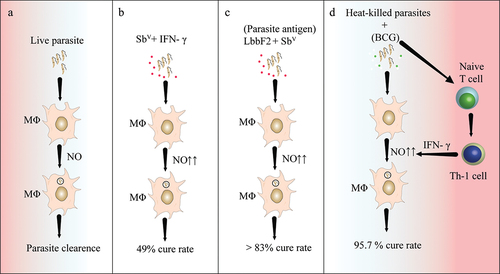Figures & data
Table 1. Drugs used for treatment of various forms of leishmaniasis and their duration of treatment.
Figure 1. Immunotherapy for the treating leishmaniasis.
Leishmania, intracellular parasites, are phagocytosed by macrophages. Under the influence of cytokines such as IFN-γ secreted by other immune cells, macrophages activate NOS generation to eliminate the intracellular form of the parasite (a). Treatment of infected macrophages with a cocktail of IFN-γ and pentavalent antimoniate resulted in a 49% cure rate (b). Similarly, treatment with a mixture of parasitic antigens Lbbf2 and SbV showed a cure rate of over 83% (c). Additionally, heat-killed Leishmania, when administered with BCG, demonstrated a 95.7% cure rate. This outcome is likely attributed to the polarization of naïve T cells into Th-1 cells, which secrete pro-inflammatory molecules like IFN-γ. Subsequently, this activation of macrophages facilitates intracellular parasite clearance (d).

Figure 2. Nanoparticles as a drug delivery system.
Nanoparticles serve a crucial function in extending drug delivery periods by providing controlled release, targeted delivery, protection of drugs from degradation, enhanced solubility, and improved permeability. Their distinctive characteristics enable them to release drugs in a sustained manner, target specific tissues or cells, shield drugs from degradation, enhance solubility, and traverse biological barriers. The illustration demonstrates the controlled release of drugs over time in the absence or presence of nanocarriers.


